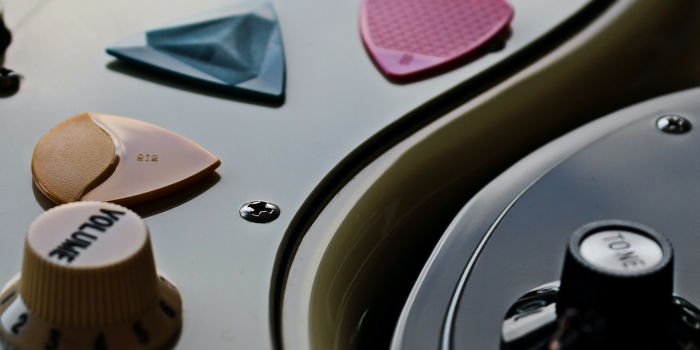What Plectrum Should I Use?

Published: 23/07/2022
Under: Guitar Gear
Picks (or plectra – which is the plural of plectrum!) take many and varied forms. But with so many options available, you might wonder what plectrum should I use when playing guitar?
Here’s what you need to know when deciding what plectrum to use.
Like pickin’ options?
Before we jump into discussing what plectrum to use, it’s worth talking about picking options. You don’t always have to use a guitar pick!
Some people enjoy using a pick and their fingers, known as hybrid picking. Others, particularly those playing country music, use a thumb pick. However, most of us just use a pick.
Try all these options and see what works best for you and your style. As I’ve developed as a guitarist, I’ve moved away from only using a pick, to hybrid picking.
I’ve also become good at tucking a plectrum between my 2nd and 3rd fingers, allowing me to use it when I need it but store it away and play fingerstyle. I’ve found this is the best of both worlds.
Picking the right plectrum for the job
Each pick has its own sound and is ideal for a particular use or two. You wouldn’t use the thickest pick you have on an acoustic when trying to get a lazy and bright sound. You’d use a really thin one.
If you wanted to get a really tight funk sound, your pick should be around the 1mm mark, allowing it to be firm enough to sound percussive, but flexible enough to move quickly.
Yes, sometimes it’s worth thinking about the qualities a pick has in relation to the application. Depending on the types of guitar you play, you might use different picks.
For example, it has always worked for me to use thinner picks on acoustic (around 1mm) and then use 1.5mm on electrics.
Sure this doesn’t always work for every style, but as a general rule, it works great. It also means that I always have both (well two of each!), in my wallet.
So, if I get called to play country (for example), I can use the 1mm rather than the 1.5mm to get a faster, more snappy tone.

How do you find what works for you?
You need to try a whole load of them out. It’s that simple. Also, you want to try using different ones from time to time.
If you’re into playing fast, when you practice, try a thicker pick. This will slow you down, but when you get back to your normal one, you’ll be superfast! (Well far faster than you once were.)
Some might be easier for you to hold as they have indents or bumps which make it easier for you to keep a hold of.
When you do stumble upon the right pick, you’ll need to buy a lifetime’s supply! But remember, you need to find the right pick for each application or situation.
Who makes the best guitar picks?
For the longest time, Dunlop guitar picks have been my brand of choice and that of many. I always keep a 1mm pick and a 1.5 mm pick in my wallet. And while I now favor the 1mm for everything, it’s still a Dunlop!
The edge from U2 uses Herdim Nylon Guitar Picks. Dominic Miller (Sting’s guitarist) uses Herco (nylon) heavy gauge plectrums.
Tommy Emmanuel uses D’Andrea ProPlec rounded triangle picks and Jim Dunlop medium thumb picks. He even sells custom picks on his website!
Over the years, a few niche brands have popped up, including V Picks, Fred Kelly Picks, and Timber Tones.
You can even buy a Pick Cutter tool and make your own!
Get a grip!
Right, so how do we hold the darn thing?! Generally, there are two ways. Surprisingly there are two ends to a pick: in technical terms ‘the point’ and the ‘fat bit’. OK? Good so far!?
You can hold it at either end, so in one case, the fat bit is showing, and you’ll get a big smooth sound, but you’ll have slightly less attack.
Or you’ll have the point showing (which is how most players use picks) and it will sound faster and brighter. In either case, you will need to hold it just with your thumb and first finger.
You want to hold it so only 2 to 3 mm is showing, with your grip tight enough for it not to move, but loose enough for it to move and get a percussive sound.

So what plectrum should I use?
You won’t know until you try a load of them and find one or two plectra that work for how you play and the music you make. It’s worth carrying a few with you and have a tin of them on your pedalboard.





Leave a Reply